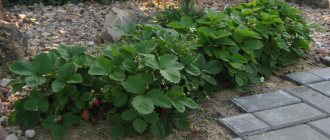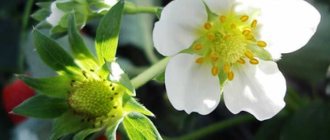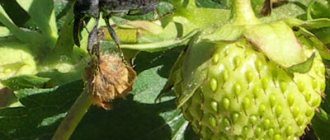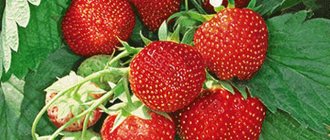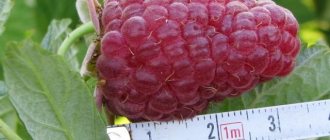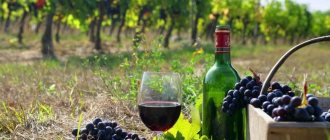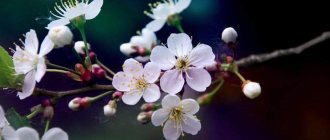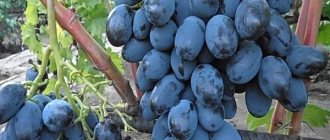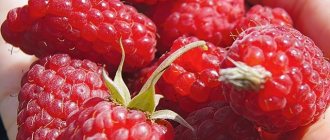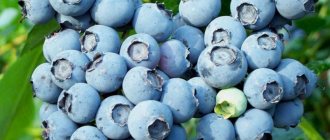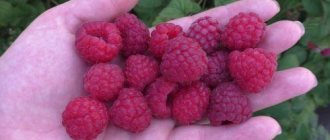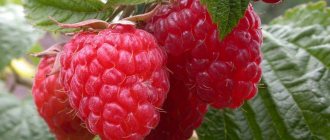Growing strawberries (garden strawberries) is a hobby for some gardeners, but a real business for others. But regardless of this, everyone tries to acquire a unique variety that would not only produce a rich harvest of delicious, fragrant berries, but also would not require much effort in care.
Remontant strawberry San Andreas meets all of the above requirements. So that gardeners can verify this, we suggest that you read the description of the variety, photographs and reviews from our readers. Let's say right away that garden strawberries of the San Andreas variety are the product of Californian breeders. It is clear that the Russian climate is somewhat different, therefore, there are special nuances when growing and caring for strawberries. Gardeners, especially beginners, should know about them.
Description of the San Andreas strawberry variety
Strawberry San Andreas belongs to the early, remontant varieties, evergreen type. Outdoor cultivation is possible only in subtropical climates. If the climate is colder, then bushes are planted exclusively in greenhouses. The bushes are large, well developed, but compact; they do not take up much space on the site. The root system is fibrous and well developed.
The peduncles are tall and bear medium-sized flowers.
The leaves are longer than most types of strawberries due to high petioles, not as rounded, more elongated and convex. The leaf blade is quite thin and prone to pubescence. The leaf color is dark green. Stipules are green-pink, not very large. Flowering begins in May. The peduncles are tall and bear medium-sized flowers. The buds are bisexual, white, with overlapping petals.
The average weight of one berry is 30 g. Although the first strawberry of the year will be larger, weighing 40-50 g. The shape of the berries is conical with a rounded tip. The color of the skin is bright red, it is shiny, soft, with an average number of seeds. The pulp is red-white, fleshy with an abundance of juice. The berries are very tasty, sweet and sour with a pronounced aroma.
Interesting!
San Andreas strawberries are often confused with the Albion variety. They are really very similar, and yet these varieties are similar only in appearance; they have different berry sizes and yields.
The average weight of one berry is 30 g
Features of the plant, propagation and agricultural technology
The bushes are small in height, medium-leafed, spherical, with a powerful root system.
The leaves are light green, slightly convex, with sharp teeth along the edges. Stipules, peduncles and tendrils have anthocyanin coloration (reddish tint). The plant-forming ability is low; during the fruiting process, the bushes throw out only a few tendrils. All the forces of the plant are aimed at the formation of peduncles (10-12 pieces each), the formation of ovaries and the filling of fruits. The inflorescences consist of large white flowers located above the level of the leaves. Since it is difficult to obtain your own seedlings, purchased seedlings are most often used to renew plantings. To obtain maximum yields, the variety is recommended to be grown in a 1-2-year culture, like most commercial remontant varieties, and for no more than 4 years in one place in amateur gardening. Plants require standard care: watering, fertilizing, mulching or loosening the soil, treating diseases and pests.
Advantages of San Andreas strawberries
Also check out these articles
- What edible mushrooms can be collected in the Moscow region
- Strawberry variety Temptation
- Description and characteristics of the Molodezhnaya cherry variety
- Pushkin breed of chickens
The San Andreas strawberry variety has many positive qualities, for which it is valued by gardeners around the world.
- The variety is suitable for cultivation in small areas for personal use or for commercial purposes in large plantations.
- There is moderate immunity to powdery mildew, verticillium wilt, anthracnose, spot and late blight.
- The root system of the plant is drought resistant.
- Bushes are almost never affected by spider mites.
- Freshly picked berries are suitable for long-term transportation.
- The taste is rated 4.5 out of 5.
- Productivity is high and stable. 700-1000 g of berries are collected from a bush per season.
- Fruiting is extended, with 2 main peaks with an interval of 4 weeks.
These are the most important qualities inherent in this variety.
The pulp is red-white, fleshy with an abundance of juice
Fruit harvesting and storage rules
In the summer months, strawberry fruits are collected in the early morning hours or in the evening, when solar activity has already subsided. Berries picked in the heat are worse in taste and quality and spoil faster. When picking in early spring or autumn, on the contrary, it is advisable to pick the berries when the sun's rays heat them, drying the morning dew from the fruit.
Berries are collected in plastic booties (1 and 0.5 kilograms) or small, flat cardboard boxes with a capacity of up to 5 kilograms. In this case, transportability and keeping quality will be maximum. After harvesting, it is advisable to cool the fruits, if possible. This procedure further increases the commercial characteristics of strawberries during subsequent transportation.
Disadvantages of the variety
The variety also has disadvantages. When growing, gardeners often note them. But how significant they are, each gardener decides for himself.
- San Andreas strawberries produce large yields for about 3 years, then the bushes need to be replaced with new ones.
- The bushes are resistant to frost down to -16 degrees.
- Despite their resistance to drought, it is not recommended to forget about watering strawberries, since a lack of water always affects the size and taste of the berries.
Interesting!
A sharp increase in temperatures negatively affects yields. In order for the bushes to continue to bear fruit normally without slowing down, it is necessary to darken them from the sun on hot days from July to August.
Another significant drawback noted by gardeners is that the variety is not suitable for growing in open ground if the climate is not hot. So you can’t do without a greenhouse.
One significant drawback noted by gardeners is that the variety is not suitable for growing in open ground.
Reproduction methods
The variety "San Andreas" reproduces well with mustaches. For this method, choose the strongest sockets. The mustaches are dug in, and when young rosettes grow on them, they are cut off from the mother bush and replanted.
Strawberries also reproduce well by division, but this method is more labor-intensive. Choose bushes older than two years. The plant is dug up and the rhizome is divided into equal parts. This procedure is best carried out in spring or late autumn.
Planting strawberries San Andreas
We recommend reading our other articles
- Bagira currant variety
- Potato variety Adretta
- How to grow eggplants in open ground
- How to grow an apricot from a seed
San Andreas strawberries are propagated exclusively by tendrils. It does not produce as many of them as the Albion variety, for example, but it is enough for propagation. To obtain tendrils, a few bushes are usually left. The flower stalks are torn from them, and the tendrils are rooted next to the bush or in cups that are placed directly on the ground in the garden bed. In one season, you can thus obtain high-quality young bushes, which are planted instead of old ones. If you buy strawberries, it is advisable to buy them from a nursery or a trusted store.
Growing strawberries is not a labor-intensive process, but it is important to plant them on time. In open ground, this variety is planted only in the south, where it is warm. As soon as the ground dries from melted snow in the spring, planting can be done. This time usually falls in March or April. In other regions, a greenhouse is selected for planting. But since the climate there is gentle, you can plant strawberries in spring or autumn, when there is time and opportunity.
Important!
San Andreas strawberry seeds are not suitable for propagation. They will not sprout, and even if sprouts do appear, they will not have parental qualities.
The site for planting strawberry bushes is chosen to be sunny, without shade, with loose, nutritious soil. The ideal soil is sandy loam. It contains enough nutrition (organics, minerals) and is loose, which is good for the fibrous roots of strawberries. The area must be drained so that water does not stagnate. If the water in the area can stagnate, it is better to make a high bed for strawberries.
If you buy strawberries, it is advisable to buy them from a nursery or a trusted store.
Before planting, the soil is dug up, all weeds are removed, and loosened so that it is soft. At this time, you can add peat and humus (1 kg/square plot). If the soil is heavy, you need to add a bucket of sand to each square meter of land to make it looser. Then separate holes about 25 cm deep are made for the plants. The distance between the holes should be at least 20 cm, and the row spacing should be 30 cm.
Water is poured into the prepared holes to keep the soil moist. At this time, the roots of the seedlings can be placed in a weak solution of potassium permanganate, Fitoverm or a similar disinfectant. After this, you can identify the sprouts in the holes and sprinkle the roots with soil. During planting, you need to ensure that the growth point of the bush is 1-3 cm above ground level. Once San Andreas strawberries are planted, they are watered and allowed to establish.
Important!
It is recommended to plant sprouts that have no more than 4 leaves. If there are more of them, rooting will slow down. The roots should be within 10 cm long.
Features of growing strawberries
In general, the technology for growing San Andreas strawberries is not much different from other early varieties, but there are certain peculiarities in this matter.
Recommended landing time
San Andreas seedlings are usually planted in the spring, immediately after the snow melts. Before the heat sets in, the plants should be well rooted. If there is a need to plant bushes in the fall, then work is planned for August or early September. An exception to these rules are seedlings with a closed root system, which can be planted throughout the summer season.
Selecting a suitable site
Strawberry beds are located in a place well lit by sunlight. Before planting bushes, the area is thoroughly weeded and the soil is filled with mineral and organic fertilizers.
Preparation of planting material
The strawberry chosen for planting must have a heart thickness of at least 1 cm. The fibrous root system of healthy plants is well developed, the roots are white or light brown in color. For planting, choose bushes without signs of pest or disease damage.
If you are purchasing seedlings with a closed root system, then preference is given to those in which the bush is powerful, stocky, the leaf apparatus is well developed, and the leaf color ranges from green to dark green.
Planting process
Planting San Andreas strawberries with closed roots is done in a previously prepared hole, placing the earthen ball flush with the ground. If the roots are slightly tangled at the bottom of the pot, then they must be carefully straightened. Saplings with an open root system are placed in the hole so that the heart is at ground level. After planting, the bushes are watered abundantly.
Strawberry care
After planting, it is important to provide optimal care to the strawberries, then they will quickly take root and grow.
- The root system of San Andreas strawberries goes deep into the ground to a maximum of 10 cm, that is, it is in the upper layers of the soil, from where water quickly disappears. So watering is carried out quite often so that the root system has enough liquid.
- Since water from the upper layers of the soil quickly evaporates, and this is where strawberry roots are located, it is recommended to mulch the beds after planting. Mulch will retain more water in the ground, protect plant roots from overheating in the summer heat, and will also serve as additional nutrition. Sawdust, straw, peat, and pine needles can be used as mulch for strawberries. In addition, weeds grow much less frequently on mulched soil.
The soil is loosened as the mulch is replaced.
Interesting!
After planting San Andreas strawberry bushes, the first flowers may appear after 2 months. It is advisable to cut them off so that the bushes will bloom en masse and abundantly.
- The soil is loosened as the mulch is replaced. To do this, it is necessary to remove the old mulch, loosen the soil and lay down new mulch. They do this once every month or two.
- Weeds are always removed when they appear. You cannot delay this, since mature weeds have a strong root; when the weed is taken out of the ground, it can catch the strawberry roots and damage them.
- In order for San Andreas strawberries to bear fruit well in subsequent years after planting, it is necessary to remove all emerging flower stalks in the first year. You can leave 1-2, just to try what the berry will be like.
- For fertilizer, it is better to combine or alternate organic matter and minerals. The NPK complex is taken from minerals in a ratio of 10:10:10%. From organic matter - infusion of manure, humus, wood ash. Strawberries need fertilizer most of all during the active period of development and after fruiting in order to recover.
- San Andreas strawberries need to be covered for the winter, otherwise they may freeze. Around the bushes and between the rows, mulch is laid out in a layer of 7 cm. If the winters are very frosty, the mulch can be laid on top of the bushes, but so that air passes through it. True, this is usually not required, since snow is the best shelter from frost for the above-ground parts of plants.
Well-groomed bushes always bring more harvest, so it is not recommended to neglect care, because hard work in the garden pays off with a large, tasty harvest!
Growing and care
It is recommended to plant strawberries in two rows with a gap of 25-30 cm between seedlings. Row spacing should be mulched:
- corn leaves;
- straw;
- black agrofilm.
Young strawberry seedlings need to start feeding 1 month after planting. Then fertilizers are applied to the soil every 10-14 days.
Before flowering begins, you can enrich the soil with ready-made mineral fertilizers, but once the ovaries begin to form, the plants are fed only with organic matter.
Seedlings begin to be planted in the beds after the onset of stable air temperatures. San Andreas is a heat-loving variety and does not tolerate frost well. In the Krasnodar region, garden crops can be planted in early April; in the Voronezh region, spring comes about 2-3 weeks later.
Important! Strawberries planted in September produce a good harvest the very next year. No special manipulations are needed to successfully cultivate this variety of strawberries.
All care is based on a standard scheme. San Andreas strawberries, like other varieties, need to be watered and fed in a timely manner. Loosen the soil the next day after watering. To reduce the amount of labor, the gaps between the berry bushes are covered with mulch film. Beds covered with mulch do not need to be weeded or loosened. In areas covered with film, moisture is better retained and nutrients are consumed more efficiently
No special manipulations are needed to successfully cultivate this variety of strawberry. All care is based on a standard scheme. San Andreas strawberries, like other varieties, need to be watered and fed in a timely manner. Loosen the soil the next day after watering. To reduce the amount of labor, the gaps between the berry bushes are covered with mulch film. Beds covered with mulch do not need to be weeded or loosened. In areas covered with film, moisture is better retained and nutrients are consumed more efficiently.
Mulching film
In particularly hot regions, it is recommended to cover strawberry beds with black and white mulch film. The white outer layer should partially reflect the sun's rays and regulate soil temperature, preventing overheating of the plant root system.
Strawberries are planted next to tall crops or necessarily covered with a net for the period from June to August in hot and dry regions:
- Krasnodar region;
- Stavropol region;
- Volgograd region;
- Astrakhan region;
- in the Salsky district of the Rostov region.
Diseases and pests of San Andreas
San Andreas strawberries do not get sick often due to their stable immunity. And it is rarely affected by pests. But, in order to be calm about young and adult plants, preventive treatments can be carried out. They are made several times a season.
When the first flower stalks appear, treatment is carried out
- When the first flower stalks appear, treatment is carried out with a mixture of Topaz, Fufanon and Horus. If the plants have not been sick before, you can choose just one.
- During flowering, you can spray the bushes with a solution of boric acid to attract pollinators and drive away pests.
- After collecting the last berries, the strawberry leaves must be cut off and the area treated with Ridomil, Tiovit or Fufanon. They will destroy the pests, and the bushes will then produce new leaves.
To prevent diseases and pests, it is very important to pull out weeds on the site in a timely manner and burn them. After all, it is through weeds that diseases and eggs, larvae, and harmful insects are most often transmitted to cultivated plants.
Growing and care
Foreign strawberries have their own nuances that are associated with cultivation and care.
Watering
If you approach the issue of watering strawberries incorrectly, you can lose the harvest and even destroy the plants. Prolonged stagnation of moisture will lead to the development of gray rot. If the soil dries out for a short time, the bush will wither, the ovaries will not develop, and the taste will deteriorate. Gardeners are helped out by a drip irrigation system that evenly distributes moisture throughout the garden bed. When dry, hot weather sets in, San Andreas is watered every 3-4 days.
Loosening, weed control
For good breathability, you need to regularly loosen the soil. To prevent weeds from growing, mulching material such as pine needles, sawdust, and straw is used. Such mulch will also be needed to prevent heavy berries from getting dirty on the ground. Strawberries of the San Andreas variety, which grow in clean, weed-free and debris-free beds, hardly get sick.
Removing a mustache
San Andreas gives little mustache. You won't need to trim them as often. If you plan to propagate a bush, leave the rosettes of the first order, they are the strongest. Although, if we talk specifically about San Andreas, then all rosettes of this variety are distinguished by excellent survival rate, a powerful root system, and quickly catch up in the development of their stronger counterparts.
Top dressing
A large-fruited crop needs increased nutrition, since it can “carry out” a large amount of nutrients from the soil over the course of a season. Feeding is done according to the following scheme:
- in early spring, nitrogen fertilizers are used to promote the formation of green mass (20 g of urea per m2 or a bucket of rotted manure);
- in May, adult bushes are watered with an aqueous solution of mullein (1:10) or bird droppings (1:20);
- complex mineral fertilizers, which include nitrogen, phosphorus and potassium, manganese and other microelements, are applied during the period of active flowering; you can use wood ash at the rate of 1 cup per m2;
- At the end of fruiting, the best organic fertilizer will be leaf compost, which is evenly spread over the garden bed.
Feeding remontant strawberries begins in the second year of the bush’s life.
Pest and disease control
The San Andreas variety successfully resists many diseases and pests. It helps to avoid epidemics by growing garlic, dill, calendula and parsley near strawberries. A good prevention of powdery mildew and white spot is timely removal of weeds and good soil drainage. After harvesting, the strawberry beds are deeply loosened and treated with 1% Bordeaux mixture. This technique allows the plant to go to winter without infections and overwintering larvae.
Before flowering, 2 feedings of Fitosporin-M are carried out, which are repeated after harvesting.
Preparing for winter
In the south, the San Andreas variety will do without shelter. The declared frost resistance of -25C has already been tested experimentally by gardeners.
In the Moscow region and in the north of the country, the beds are mulched with compost, leaves, covered with spruce branches, and arcs are installed for agrofibre. During the thaw period, strawberries are opened to prevent the bushes from rotting.
Harvesting and processing
The harvest ripens in June, namely 5-7 weeks after flowering. When overripe, the berries continue to retain their shape and the pulp does not soften. And yet, it is not recommended to delay harvesting too much, since when the berries are overripe, they may begin to lose their taste, marketability and transportability. In addition, overripe strawberries do not last long. The berries ripen together. These strawberries can be harvested from June to mid-autumn, so the berries are harvested approximately once every 3-7 days, as they ripen.
Important!
In order for strawberries to get sick less often and bear fruit well, it is necessary to regularly pick or cut off all dry, damaged leaves from the bushes.
San Andreas strawberries make delicious juice, compotes, jams, and in jam the berries retain their shape and do not fall apart
Fresh strawberries do not last long. It can lie for about 2 weeks without spoiling if it is collected in time, but then it begins to rapidly deteriorate. You can eat this variety of strawberries fresh. It is also suitable for freezing, drying or canning. It produces delicious juice, compotes, jams, and in jam the berries retain their shape and do not fall apart.
Video
The following videos filmed by experienced gardeners and professional farmers in Belarus, the Oryol region and the Krasnodar region tell about the potential of the variety:
For several years she worked as a television program editor with leading producers of ornamental plants in Ukraine. At the dacha, of all types of agricultural work, she prefers harvesting, but for this she is ready to regularly weed, pull, shed, water, tie, thin out, etc. I am convinced that the most delicious vegetables and fruits are those grown with your own hands!
Found a mistake? Select the text with the mouse and click:
A new product from American developers is the Tertill robot, which weeds weeds in the garden. The device was invented under the leadership of John Downes (creator of the robot vacuum cleaner) and works autonomously in all weather conditions, moving over uneven surfaces on wheels. At the same time, it cuts off all plants below 3 cm with the built-in trimmer.
Oklahoma farmer Carl Burns developed an unusual variety of multi-colored corn called Rainbow Corn. The grains on each cob are of different colors and shades: brown, pink, purple, blue, green, etc. This result was achieved through many years of selecting the most colored ordinary varieties and crossing them.
Both humus and compost are rightfully the basis of organic farming. Their presence in the soil significantly increases the yield and improves the taste of vegetables and fruits. They are very similar in properties and appearance, but they should not be confused. Humus is rotted manure or bird droppings. Compost is rotted organic remains of various origins (spoiled food from the kitchen, tops, weeds, thin twigs). Humus is considered a higher quality fertilizer; compost is more accessible.
From varietal tomatoes you can get “your own” seeds for sowing next year (if you really like the variety). But it is useless to do this with hybrids: you will get seeds, but they will carry the hereditary material not of the plant from which they were taken, but of its numerous “ancestors”.
You need to collect medicinal flowers and inflorescences at the very beginning of the flowering period, when the content of nutrients in them is highest. Flowers are supposed to be picked by hand, tearing off the rough stalks. Dry the collected flowers and herbs, scattered in a thin layer, in a cool room at natural temperature without access to direct sunlight.
“Frost-resistant” varieties of garden strawberries (more often simply “strawberries”) need shelter just as much as ordinary varieties (especially in those regions where there are snowless winters or frosts alternating with thaws). All strawberries have superficial roots. This means that without shelter they freeze to death. Sellers’ assurances that strawberries are “frost-resistant,” “winter-hardy,” “tolerates frosts down to −35 ℃,” etc. are deception. Gardeners must remember that no one has yet managed to change the root system of strawberries.
Natural toxins are found in many plants; Those grown in gardens and vegetable gardens are no exception. Thus, the seeds of apples, apricots, and peaches contain hydrocyanic acid, and the tops and peels of unripe nightshades (potatoes, eggplants, tomatoes) contain solanine. But do not be afraid: their number is too small.
The homeland of pepper is America, but the main breeding work on developing sweet varieties was carried out, in particular, by Ferenc Horvath (Hungary) in the 20s. XX century in Europe, mainly in the Balkans. Pepper came to Russia from Bulgaria, which is why it received its usual name - “Bulgarian”.
Convenient Android applications have been developed to help gardeners and gardeners. First of all, these are sowing (lunar, flower, etc.) calendars, thematic magazines, and collections of useful tips. With their help, you can choose a day favorable for planting each type of plant, determine the timing of their ripening and harvest on time.
Reviews from gardeners about the San Andreas variety
Below are reviews from gardeners and gardeners who have already tried to grow San Andreas strawberries on their plots.
- Trofim Ershov : “I tried to grow San Andreas strawberries 2 years ago. The seedlings were brought from England and planted in a couple of days. The bushes, of course, grew beautifully, there are a lot of flower stalks - there are no complaints here, but the berries are not aligned, there are some curved ones, which I didn’t like. Albion has no such problems. In addition, the San Andreas berries seemed too soft to me, I’m not sure they will survive transportation, and the taste is rustic. So I’d better replace it with another variety.”
- Nadezhda Pavlova : “I love strawberries very much, so I’m constantly looking for the best varieties. Growing San Andreas, I thought, would be real torture; after all, the variety is imported. But it turned out that it is growing, like ours, domestically, quickly and without any problems. I liked the taste, the aroma is simply incredible! But alas, the yield is at an average level. As for me, 0.6 kg per bush is not enough per season for a remontant variety, especially since San Andreas has large berries. So I will continue growing, but only for food, not for sale.”
- Olesya Alexandrova : “A friend recommended the San Andreas strawberry variety to me. I don’t have much space on my plot, so I need a variety with compact bushes. I took several seedlings for testing and planted them in a greenhouse, because our climate is cool. I have been growing this variety for 2 years now, and will propagate it again. Everyone likes strawberries - taste, yield, appearance. Of course, there are twisted berries, but this is rare. Besides, I don’t sell my harvest, so marketability is not particularly important to me!”
Origin and official registration
In commercial production in heated greenhouses, crops are obtained almost all year round
The variety is officially approved for cultivation throughout Belarus (included in the State Register in 2014). It is not registered in Russia and Ukraine, but is already quite widely cultivated (especially in the southern regions), showing stable productivity in open and protected ground. In the middle zone, the results are not so impressive, but gardeners note the winter hardiness of the variety (up to −16 ℃), its relative resistance to spring/autumn frosts and droughts, undemandingness to soil types, and high marketable and consumer qualities of the fruit.
We invite you to familiarize yourself with Bear's Paw: description of the tomato variety, characteristics of tomatoes, sowing
